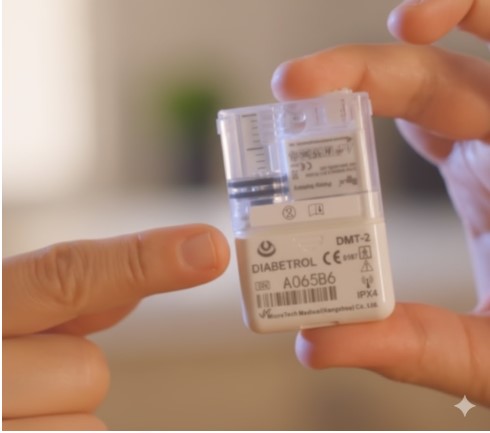For many living with diabetes, the daily routine has been one of constant calculation, vigilance, and physical encumbrance. The traditional insulin pump, though a significant step up from multiple injections, kept users physically tethered to their therapy via a long plastic tube. This “leash” was a source of practical frustration and a constant reminder of their chronic condition. Now, a new wave of innovation is severing that final physical tie. The pump patch has emerged as a transformative technology, consolidating the power of an insulin pump into a discreet, tubeless pod that adheres directly to the skin, heralding an era of unprecedented freedom and normalcy in diabetes care.
Redefining Normal: Life Without Tubes
A pump patch is a compact, self-contained insulin delivery system. It integrates the insulin reservoir, the electronic pumping mechanism, and the cannula into a single, wearable unit. This pod communicates wirelessly with a handheld controller or a smartphone app, which the user operates to manage their insulin delivery. By eliminating the infusion set tubing—long considered the primary weakness of conventional pumps—the pump patch addresses a multitude of user complaints.
The advantages of this tubeless design are profound and immediate:
Complete Freedom: Activities like sports, swimming, and even sleeping become simpler and safer without the risk of snagging or kinking a tube.
Enhanced Discretion: The small, low-profile pods can be worn under clothing on various parts of the body, making the therapy virtually invisible to others.
Waterproof Convenience: Most pods are waterproof, allowing users to shower and engage in water activities without interrupting their insulin delivery.
Simplified Use: The application process is often streamlined, with many patches featuring an automated, nearly painless cannula insertion at the press of a button.
This shift to a tubeless model is not just about comfort; it’s about reclaiming a sense of normalcy. It allows individuals to participate more fully in life, with their diabetes management system working quietly in the background rather than being a constant, physical presence.
The Smart Synergy: Automation with CGM and Pump Patch
The true power of the modern pump patch is unleashed when it is integrated into an Automated Insulin Delivery (AID) system. These systems create a closed-loop of communication between the patch, a Continuous Glucose Monitor (CGM), and a sophisticated control algorithm. This digital ecosystem works tirelessly to optimize glucose control with minimal user intervention.
The CGM, like the Aidex CGM, acts as the system’s scout, continuously monitoring glucose levels and providing a rich stream of data. The algorithm, the system’s strategist, analyzes this data to forecast glucose trends and make predictive adjustments. Finally, the pump patch, the system’s effector, receives wireless commands from the algorithm and executes them with precision, modulating the background insulin delivery to keep glucose levels stable.
This automated partnership turns reactive management into proactive control. It can preemptively counteract rising glucose after a meal or suspend insulin delivery to prevent an overnight low, one of the most feared complications of insulin therapy. For the user, this means more time spent in their target glucose range, a lower risk of long-term complications, and a dramatic reduction in the cognitive load of managing diabetes.
A New Standard in Diabetes Care
The pump patch represents a fundamental shift in the design philosophy of medical devices. It moves away from a one-size-fits-all model to a more personalized and human-centric approach. By prioritizing user experience, freedom, and discretion, it addresses not only the clinical needs but also the emotional and lifestyle needs of people with diabetes.
The technology has evolved to offer a spectrum of options, from simple bolus-only patches for those with type 2 diabetes to highly advanced, algorithm-driven systems for intensive management of type 1 diabetes. This demonstrates a growing understanding that effective therapy must adapt to the individual, not the other way around. As this technology continues to advance, integrating with ever-smarter algorithms and more accurate CGMs, the pump patch is setting a new standard for what it means to live well with diabetes—untethered, unburdened, and in control.
Frequently Asked Questions
What is the core advantage of a pump patch?
The core advantage is its tubeless design, which offers complete freedom of movement, enhanced discretion, and the convenience of being waterproof. It eliminates the practical and psychological burdens associated with the tubing of conventional insulin pumps.
How is a pump patch different from a CGM patch?
A pump patch and a CGM patch serve two different functions. A pump patch (like Omnipod or Equil) delivers insulin into the body. A CGM patch (like Aidex or Dexcom) has a sensor that measures glucose levels from the body. In an AID system, the two devices work together, with the CGM providing the data and the pump patch acting on it.
Does a pump patch hurt?
Most users find the application of a pump patch to be nearly painless. The pods typically feature an automated insertion mechanism that deploys a small, flexible cannula under the skin quickly and smoothly.
How long can you wear a single pump patch?
The wear time varies by model. Most full-featured patches designed for type 1 diabetes, which deliver both basal and bolus insulin, are worn for up to 3 days. Some simpler patches may have a wear time as short as 24 hours or as long as 4 days.
Is switching from a traditional pump to a pump patch difficult?
While the underlying principles of insulin therapy are the same, there is a learning curve. Users need training on how to fill and apply the pod, use the wireless controller, and understand the specific features of their new system. However, many find the overall process to be simpler and more user-friendly than traditional pump management.
 :
https://aidexcgm.com/pages/equil-insulin-pump
:
https://aidexcgm.com/pages/equil-insulin-pump

